
I am not a bullpup guy. Two reason for that: First off, I've spent a pretty reasonable amount of time shooting guns where reloading involved inserting a magazine into a hole in front of the trigger, and secondly, I'm left handed. And in case you blessedly unaware righties haven't noticed, most bullpups involve a bolt whizzing back and forth past the meat of your cheek. If there happens to be an ejection port there... well, it's not a ton of fun. I'm looking at you, Norinco Type 97.

But now there's this: The Kel-Tec RDB. A non-restricted, fully ambidextrous, downward-ejecting bullpup chambered in 5.56 that's set to hit the market for around $1,500.

Anyway, it is literally that simple; it's a bullpup rifle that dispenses its spent casings through an ejection port behind the magazine well, on the bottom of the gun.
Obviously doing this involves a bolt that travels a bit farther than the average rifle's, as the bolt needs to traverse the entire distance of the magazine well, and then at least a case-length's span beyond that in order to eject the spent casing through the ejection port. To do this, the Kel-Tec RDB relies on an adjustable short-stroke gas-piston system that utilizes a combined gas piston/bolt carrier/op-rod/op-rod guide that houses a sort-of-AR-15ish rotating bolt, albeit with the rounded lugs that are becoming so en vogue and dual plunger-style ejectors.
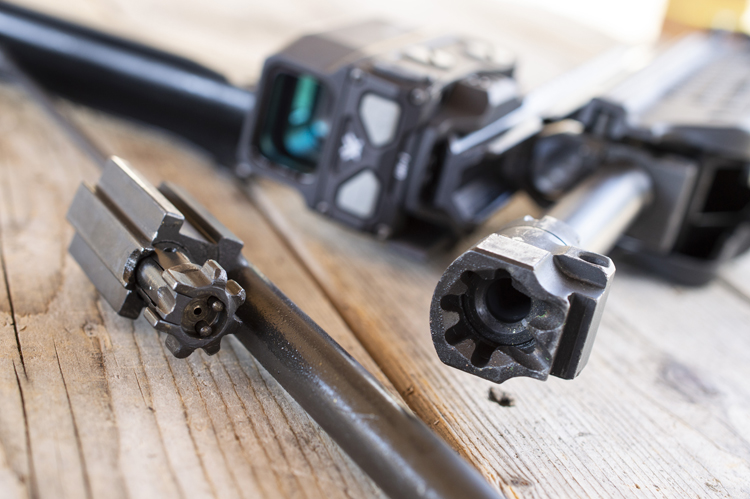

The Kel-Tec RDB is different. Since it ejects downward, the rifle can be shot by both lefties and righties alike. The magazine release is central, so it too doesn't discriminate, and both the 45-degree safety and simple bolt release are present on both sides of the rifle. The only thing that needs to be adapted is the charging handle, which is simply pulled out of the rifle and inserted on the other side.
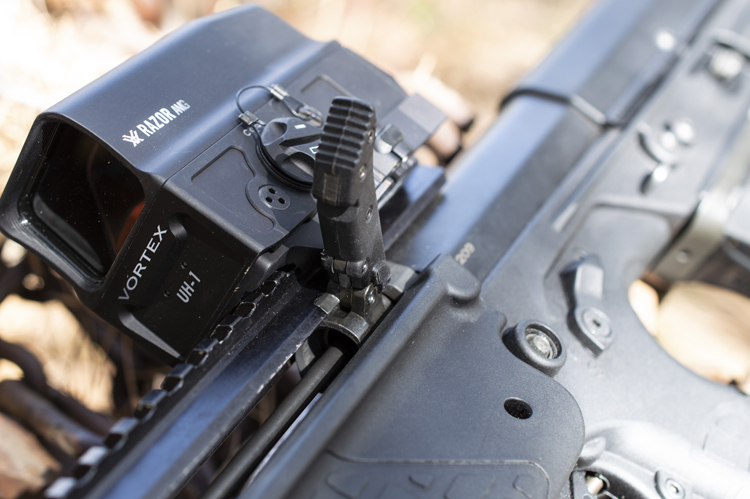
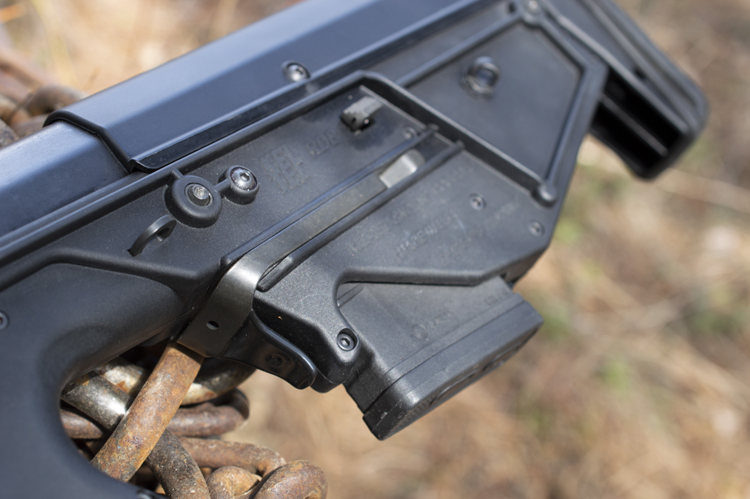
Rounding out the RDB's exterior features are a myriad of sling attachment points; two MASH hook points on each side, two molded in loops on the front of the handguard, and one molded loop on the back.
As with all bullpups, the small explosion that propels the bullet downrange happens right under your face, so it's somewhat more important that such a gun be built from quality materials to assuage any concerns that an untoward kaboom moment might turn you into Two Face of Batman fame. In the case of the Kel-Tec RDB, that comfort comes from a 1.5 millimetre thick (just shy of 1/16th inches) piece of sheetmetal bent into a u-shape, which forms the upper receiver. Inside this u-shape piece, two reinforcing strips are installed on either side, and serve as guide rails for the abbreviated bolt carrier (while also providing purchase for the screws holding the cheekrest onto the receiver's exterior). The rear of the receiver is given additional rigidity via a small piece that's welded along the bottom the receiver to form a box. Inside the box, a small stud is installed to locate the end of the operating rod, and a nylon buffer is fitted.
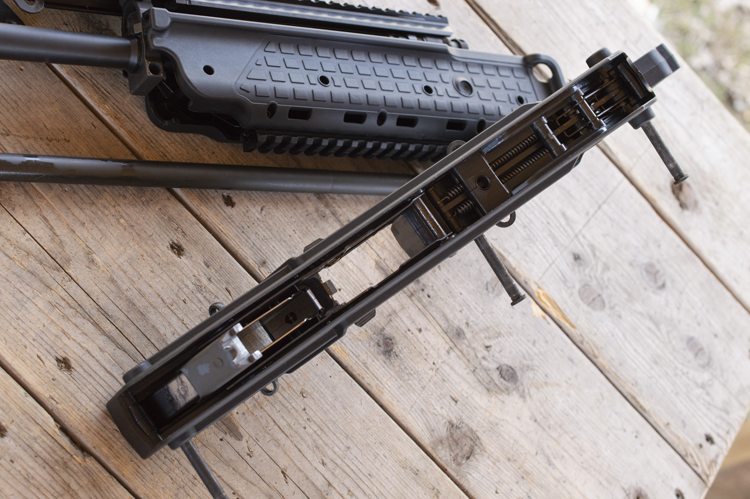
Finally, we come to the last components: The bolt and barrel. On the model pictured, which is the commercial US model imported and sent to the RCMP for examination, the barrel is 17.4 inches long. On Canadian non-restricted models, the barrel will be 20 inches long, and will feature a 1 in 7 twist rate (this early production sample is 1:9). For the truly geeky, the barrels are AISI 4140 steel, have six grooves in the rifling that twist to the right, and have a corrosion-preventing salt bath nitride treatment internally.
More interesting is the way the barrels are assembled. They use an AR-15 style barrel extension that's threaded onto the breech, and then locked in place by a lock nut, allowing headspace to be set in much the same way as it is set on a Savage bolt action rifle. This allows for manufacturing tolerances to be compensated for while still obtaining appropriate headspacing. Conversely, AR-15s are more like Remington 700s, where precisely made barrel extensions are threaded onto precisely machined barrel tenons and tightened up against a shoulder machined onto the barrel profile. Also, due to the inability to thread the full length of an AR-15 barrel tenon right up the shoulder, a rebated area between the threaded portion and the shoulder creates a weak point in all AR-15 barrels where the chamber wall is both thinner and unsupported by the barrel extension. This isn't so on the Kel-Tec RDB barrel, as it is threaded beyond the extension and lock nut, meaning there is no rebated, thinner portion and the lock nut and barrel extension can completely support almost the entire chamber. In short, this is very strong gun.
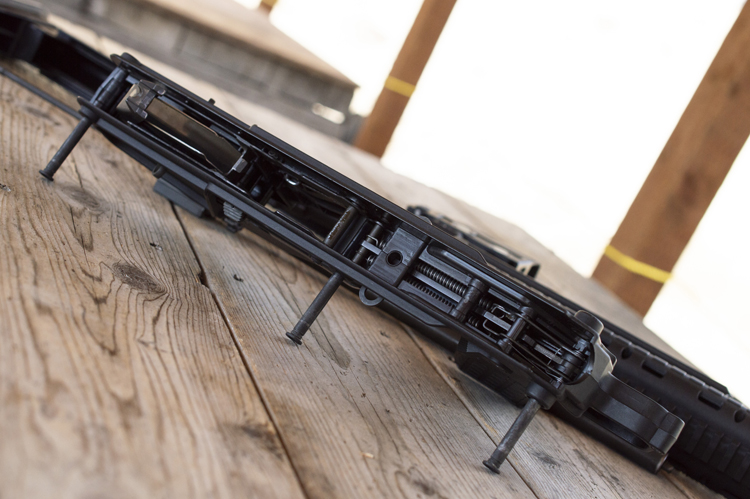
The bolt was clearly made with similar logic. Borrowing from the AR-15's bolt head obviously saves engineering time, but Kel-Tec has rounded the lugs; a feature many high-end AR-15 manufacturers are adopting to increase reliability. It operates on a cam pin that forces the bolt to rotate inside the carrier as the carrier is pushed fore and aft, and the cam pin is retained by the firing pin. If any of that sounds familiar, it should: It's basically the exact same principle as the AR-15's bolt operation. The only substantive differences are that there's a small spring between the bolt body and firing pin (serving to keep the firing pin to the rear during operation), and that the carrier is just an inch and a half long and suspended from an operating rod. Due to the bolt needing to traverse such a distance to eject a spent round, the shorter the bolt assembly, the shorter the receiver can be. The operating rod, by the way, also forms the gas piston and cycles fore and aft on a captive guide rod that lives inside it. The recoil spring driving the gun's operation is also captive, inside the operating rod.
With most bullpups, the problem with them is twofold: The manual of arms is weird and the triggers are varying degrees of "remind me again why this is a better platform than a conventional gun." Generally, it seems like the farther a trigger is from the thing it's triggering, the worse it feels.
Not so with the Kel-Tec RDB. Truth be told, were we to close our eyes, the RDB trigger would be nearly indistinguishable from the well broken-in GI trigger in our Colt Canada rifles. Nearly. The break is uber-crisp, right around 4.5 pounds, and very consistent. There's no weird flexy-feeling hitchiness in it, nor any grit to be found; you pull back and after enough pressure is exerted, it just breaks. But, there's more overtravel than an AR-15's (not that it's excessive, just different), and the reset is both farther away and a lot less pronounced. There's none of the AR's nice tactile reset that you feel in the trigger, and even the faint audible snap the sear makes is noticeably far away, literally. It's like five inches from your ear and you'll never hear it with ear protection on. But, with that one caveat, it's fantastic.
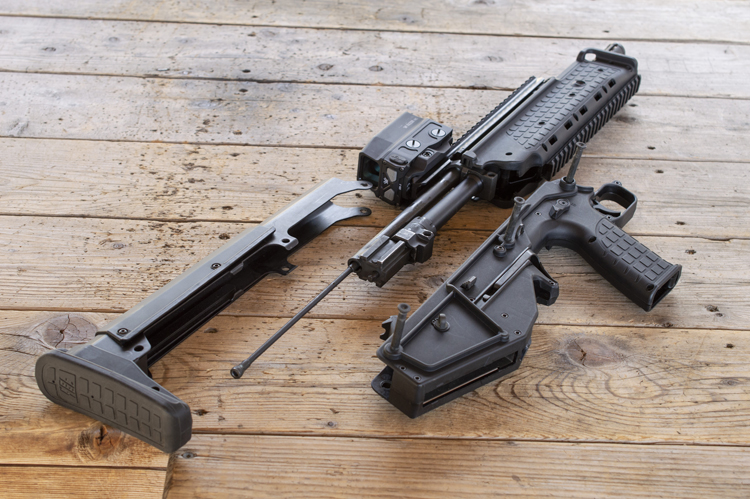
In terms of operation, we did have some trouble with the Kel-Tec RDB that we initially and incorrectly thought was the result of certain magazines not feeding correctly. As it turns out, the issue lie with the gun's almost infinitely variable gas regulator. As delivered from the RCMP evaluation lab, the gas pressures were turned up as high as possible, leading to an issue with double feeds or rounds simply being driven into the breech face rather than the trigger. It reminded us of the issue we initially had with the Type 97, which was also caused by the regulator being turned up too high, so we simply adjusted the RDB's gas system until it worked. But, we should note that owners would be well served to find a magazine they like and stick to that one type, as doing so will really let you dial the gas system in. Gen 3 Pmags were the most widely reliably (they worked across the most gas settings), but Lancer mags let us turn the gas down the lowest for the softest recoil.
And boy, was it soft. Even with Pmags or USGI mags and the gas system turned up slightly, the RDB is a pussycat. Is it softer than an AR? Well, that's really difficult to say. We would lean towards "probably," if only because it did feel a bit softer and logically, all that extra bolt travel is just giving the gun a better chance to bleed off energy that'd otherwise be introduced to your shoulder. Fitted with some sort of compensator or brake, this thing would be absolutely hilarious in CQB matches; already comes back on target quickly and points like we wish our dog would and that's with an A2 birdcage on the end.
In terms of accuracy, this one is what we'd call rack grade with most of the bulk ammo we shoot most of the time, but we'd like to see what it could do with some 77-grain pills... especially with the commercial 1:7 twist barrels that consumer models will come with. However, due to the way the barrel is pinned to both the sight rail and chassis, it's quite the opposite of free floated so that may prove the limiting factor on the Kel-Tec RDB's accuracy. But if it'll shoot into two inches with generic 55- or 62-grain ammo? Well, that's what we expect from most service rifles (including those aforementioned far more expensive bullpups, so this doesn't disappoint.
